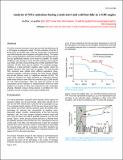Analysis of NOx Emissions during Crank-Start and Cold Fast-Idle in a GDI Engine
Author(s)
Rodriguez, J. Felipe; Cheng, Wai K
Download2017-01-0796_NOx_GDI_ColdStart_FINAL.pdf (982.9Kb)
OPEN_ACCESS_POLICY
Open Access Policy
Creative Commons Attribution-Noncommercial-Share Alike
Terms of use
Metadata
Show full item recordAbstract
The NOx emissions during the crank-start and cold fast-idle phases of a GDI engine are analyzed in detail. The NOx emissions of the first 3 firing cycles are studied under a wide set of parameters including the mass of fuel injected, start of injection, and ignition timing. The results show a strong dependence of the NOx emissions with injection timing; they are significantly reduced as the mixture is stratified. The impact of different valve timings on crank-start NOx emissions was analyzed. Late intake and early exhaust timings show similar potential for NOx reduction; 26-30% lower than the baseline. The combined strategy, resulting in a large symmetric negative valve overlap, shows the greatest reduction; 59% lower than the baseline. The cold fast-idle NOx emissions were studied under different equivalence ratios, injection strategies, combustion phasing, and valve timings. Slightly lean air-fuel mixtures result in a significant reduction of NOx. The engine-out emissions are highly sensitivity to combustion phasing. Initial retard results in lower mass NOx emissions up to CA50 around 40 °CA aTDC-compression. After this point the increase in fuel consumption and the reduction on residual fraction reverse the trend leading to an increase in NOx mass emissions for later combustion phasing. Moderate exhaust timing advance is beneficial for NOx emissions and has no impact on the exhaust enthalpy flow.
Date issued
2017-03Department
Massachusetts Institute of Technology. Department of Mechanical EngineeringJournal
SAE International Journal of Engines
Publisher
SAE International
Citation
Rodriguez, J. Felipe and Cheng, Wai K. “Analysis of NOx Emissions During Crank-Start and Cold Fast-Idle in a GDI Engine.” SAE International Journal of Engines 10, no. 2 (March 28, 2017): 646–655. ©2017 SAE International.
Version: Author's final manuscript
ISSN
1946-3944
1946-3936